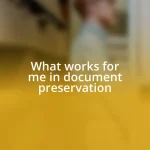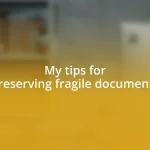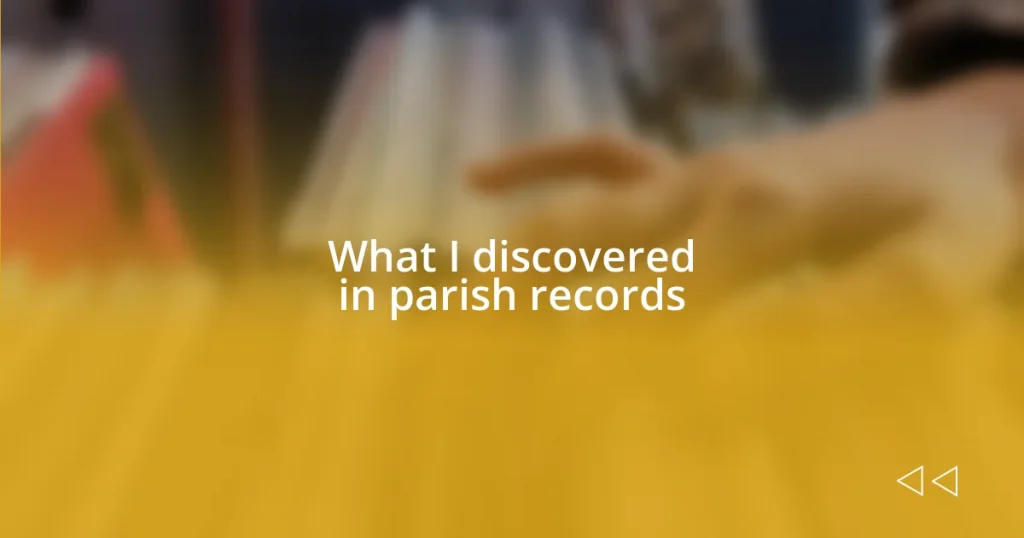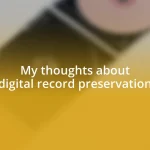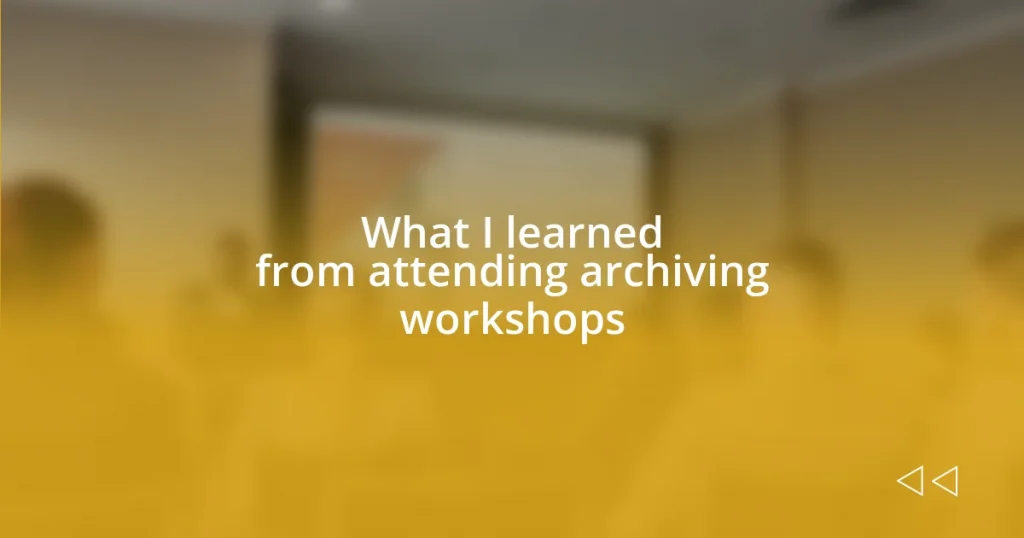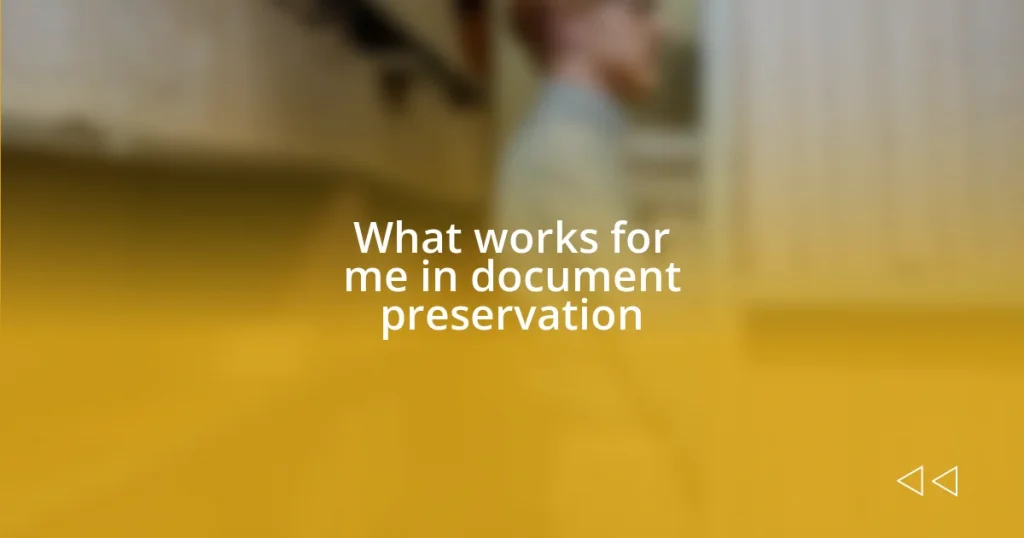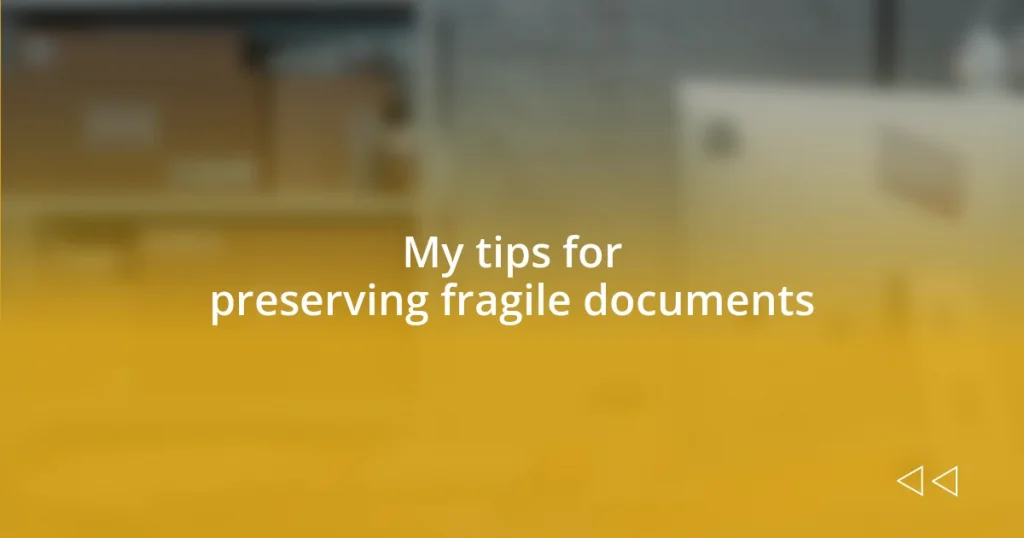Key takeaways:
- Parish records serve as valuable resources for understanding family history, revealing personal stories, social structures, and historical contexts through various types of entries such as baptisms, marriages, and burials.
- Utilizing digital resources and databases significantly enhances the accessibility and efficiency of researching parish records, allowing easier discovery of personal notes and connections within family histories.
- Overcoming challenges in genealogical research, such as deciphering old handwriting and inconsistencies in record-keeping, can be managed through strategic planning, note-taking, and communication with local historians and archivists.
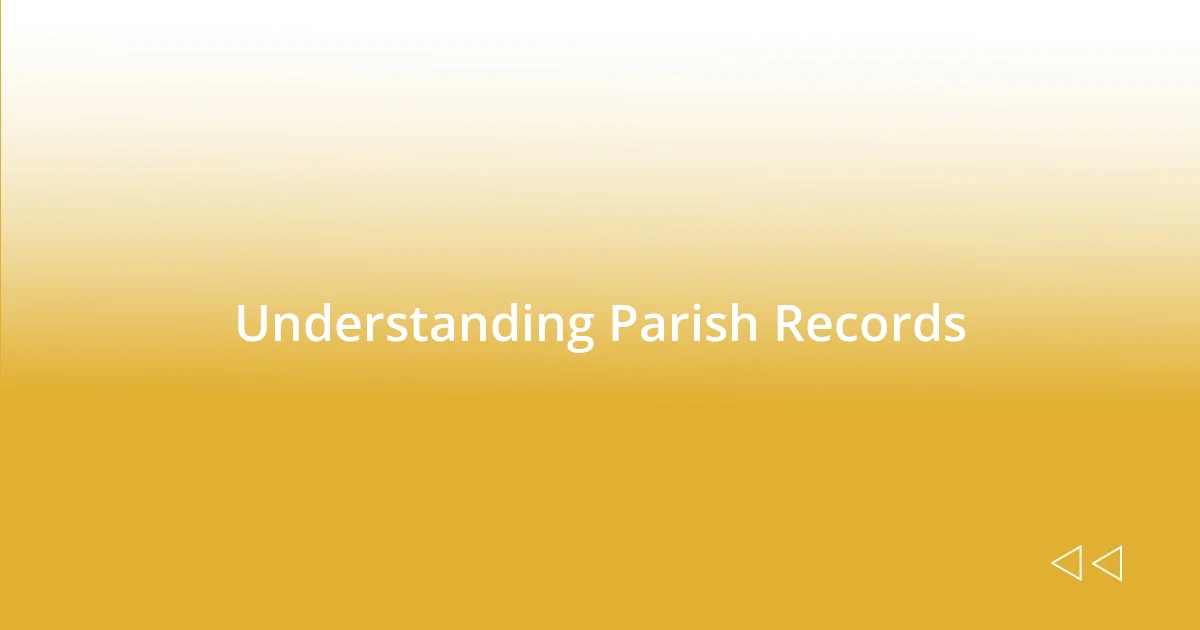
Understanding Parish Records
Parish records are like hidden treasure chests waiting to be opened. When I first delved into these documents, I was amazed at how much history they encapsulate. Each entry tells a story—births, marriages, and even burials that reflect the heartbeat of a community.
I remember the first time I discovered a record that linked me to an ancestor I never knew about. It was an exhilarating moment, almost like shaking hands with a ghost from the past. Have you ever felt that rush of connection when uncovering a family member’s name? Those records can evoke such emotions, making you realize how deeply interconnected we are with our lineage.
These documents often reveal more than just names and dates; they provide context about the times in which our ancestors lived. I find it fascinating how a single baptism record can uncover details about economic conditions, social structures, and even cultural practices of the era. Have you considered how these nuances can enrich your understanding of history? It’s incredible how parish records can transform genealogy into a vibrant tapestry of human experience.
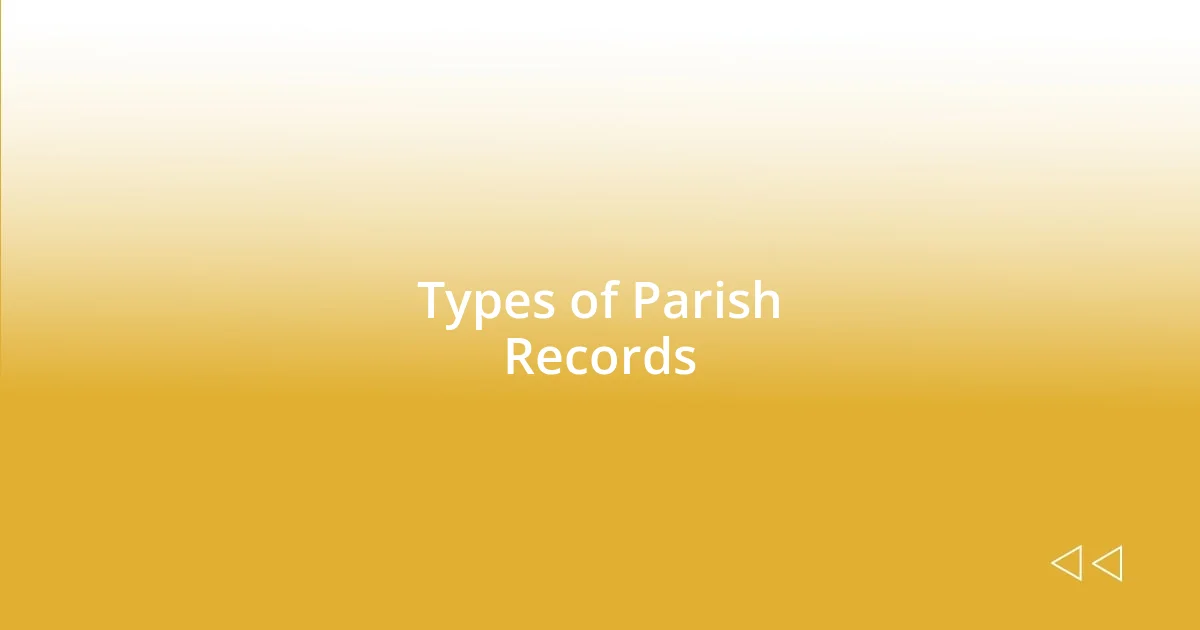
Types of Parish Records
Parish records come in various types, each serving a unique purpose and enriching our understanding of family histories. From my experience, I’ve found that these records often include vital information that can lead to surprising discoveries. Whether you’re tracing family lines or exploring community heritage, knowing the different types can be immensely beneficial.
Here are the main types of parish records I’ve encountered:
- Baptism Records: They document the birth and christening of individuals, often providing parents’ names and dates.
- Marriage Registers: These highlight unions, including the names of the couple and witnesses, which sometimes connect to extended family ties.
- Burial Entries: They can reveal the final resting places, dates of death, and often the cause of death, shedding light on past health issues.
- Census Lists: While not exclusive to parishes, these can show the population composition and demographics of the community.
- Minutes of Parish Meetings: These documents often detail local governance, social issues, and even community announcements, offering a glimpse into daily life.
Each type of record has its nuances, and I vividly recall discovering a marriage entry that not only confirmed my great-grandparents’ union but also included a note about a community celebration. It made the document feel alive, helping me to visualize the joy of that day—a reminder that history is about people, their loves, and their lives. It’s moments like these that truly deepen our connection to the past.
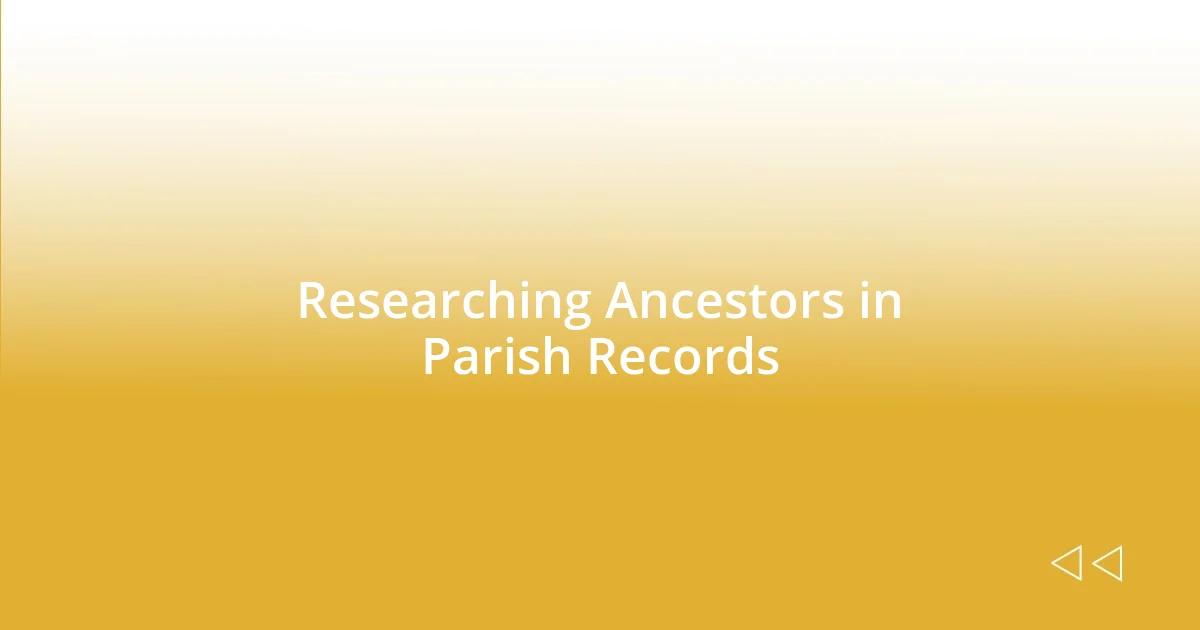
Researching Ancestors in Parish Records
Exploring parish records has been one of the most fulfilling journeys in my genealogy research. I remember one specific baptism record I found that revealed not only my great-grandmother’s name but also the names of her siblings, which I had never known about before. It was as if the past opened its arms and welcomed me into my family history. Finding these connections is incredibly rewarding, don’t you think? It’s those little discoveries that bring our ancestors back to life, making them more than just names on a page.
As I continued my research, I stumbled upon marriage registers that told tales of love and commitment, often accompanied by the names of witnesses who were likely friends or family. One entry stood out with a whimsical note about a wedding held during a harvest festival. I could almost picture my ancestors celebrating the union amidst the backdrop of cornfields and joyful laughter. That’s the beauty of parish records; they allow us to glimpse the personal stories behind historical events, making the past feel vibrant and alive.
Parish records are often organized in a way that makes them unearthed treasures. From what I’ve experienced, they can lead you down unexpected paths. For example, when I looked into burial entries, I didn’t just find dates; I discovered family plots revealing intricate webs of family relationships. Have you ever considered how a simple burial record could lead you to uncover the life story of an ancestor who may have been overlooked? Each data point can serve as a breadcrumb, guiding you deeper into the rich tapestry of your genealogy.
| Type of Record | Insights |
|---|---|
| Baptism Records | Reveal family relationships and origins, often including godparents. |
| Marriage Registers | Highlight unions and witness connections, revealing community dynamics. |
| Burial Entries | Document deaths and provide familial context, often indicating health issues. |
| Census Lists | Display demographic composition, showcasing changes in the community over time. |
| Minutes of Parish Meetings | Detail local governance, social issues, and community announcements. |
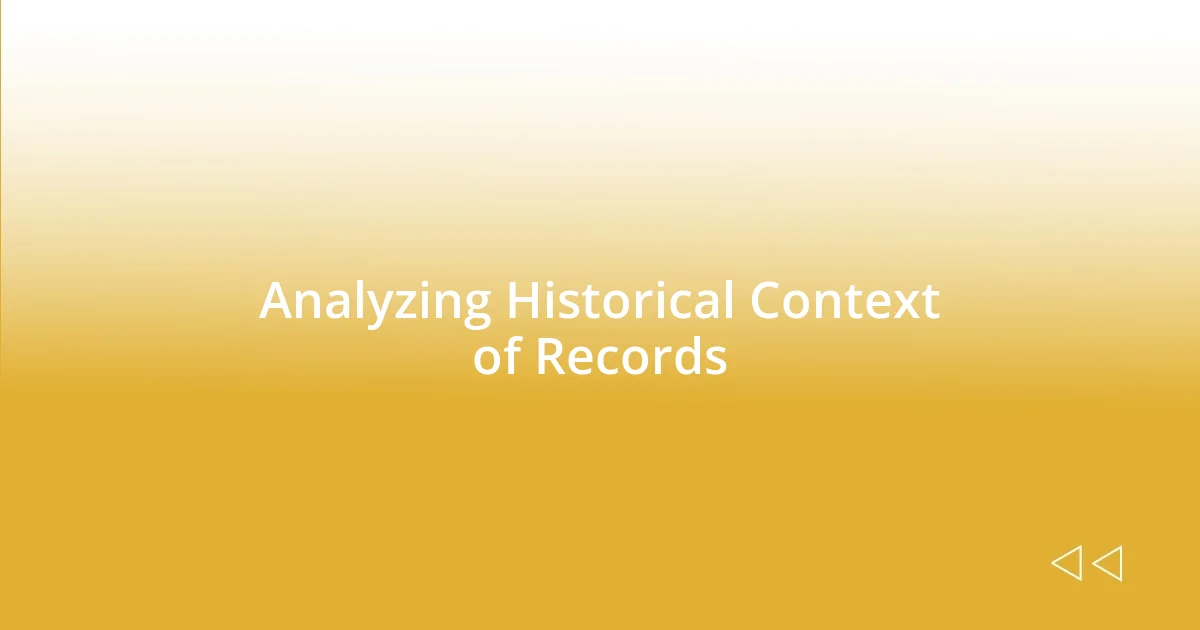
Analyzing Historical Context of Records
Analyzing parish records transports me into different times, allowing me to experience history through the lens of those who lived it. For instance, I was poring over a baptism record where the entry wasn’t just a name and date; it included an intricate note regarding the family’s residence in a small village. That context opened my eyes to the everyday realities of my ancestors—can you imagine how their lives were shaped by the community around them? Understanding this historical context transforms mere names into vibrant individuals with stories worth telling.
What often surprises me is the influence of broader historical events on local parish records. I discovered a marriage register from a time of national unrest, and the notes reflected that tension—couples marrying amidst fears of conscription and uncertainty. Such entries evoke emotions I never expected, revealing how even personal milestones were intertwined with larger societal shifts. Have you ever thought about how your ancestors faced challenges that resonate even today? It makes you realize the strength it took for them to build families and communities during tumultuous times.
Furthermore, examining minutes from parish meetings can be like peeling back layers of history itself. I found records that highlighted debates about community resources, and it fascinated me to see familiar names banded together for collective action. The emotions expressed in those meetings show their urgency; these were people invested in their community’s future. As I read, I felt connected to their passions and struggles—do you ever feel that deep sense of connection when you uncover these stories? It’s a reminder that our ancestors were not just passive figures but active participants in the rich tapestry of life.
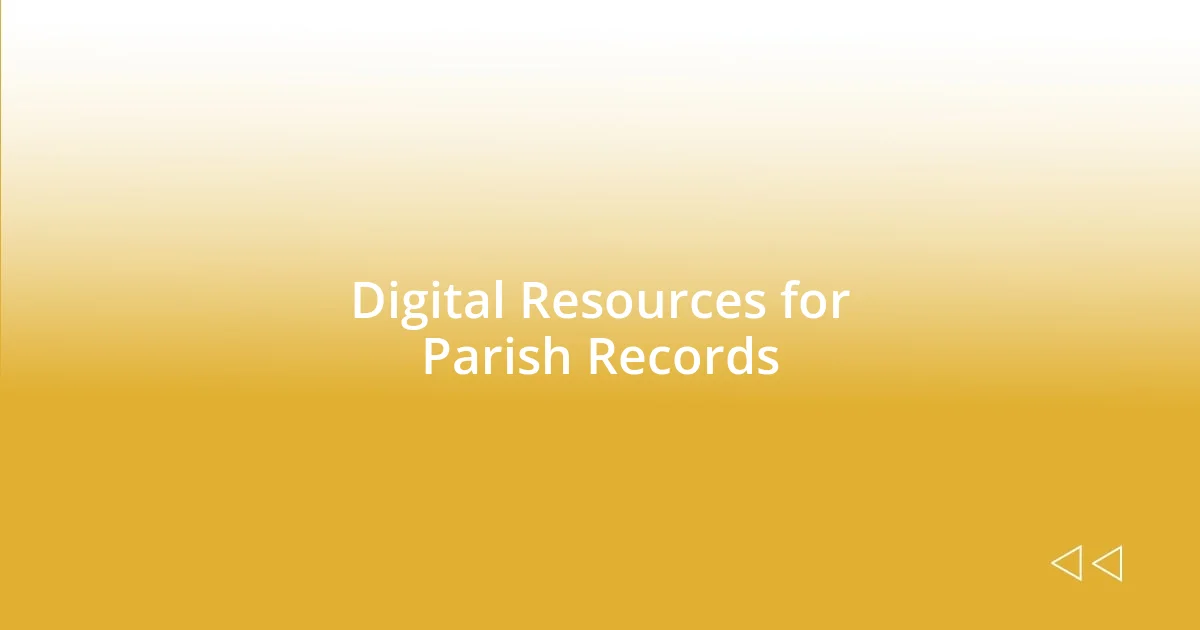
Digital Resources for Parish Records
When I first turned to digital resources for parish records, I felt like I’d opened a treasure chest. Online platforms such as FamilySearch and Ancestry have become invaluable tools in my research toolkit. I remember finding a searchable database that allowed me to access baptism records in minutes, which once would have taken hours, if not days, to sift through dusty archives. How liberating is that?
Moreover, the ability to view digitized parish records means I can examine documents from the comfort of my home, which is a game changer. I once stumbled upon an old marriage license that not only listed the couple’s names but also included their hopes for a future together written in the margins. Discovering personal notes like that instantly humanizes my ancestors—it makes me wonder what hopes or dreams guided their lives. Have you ever felt the thrill of seeing your ancestor’s handwriting? It adds such a personal touch to the research experience.
Additionally, many local libraries and societies offer access to their digitized collections through websites like the British Online Archives or regional archives. One afternoon, while scrolling through digitized parish minute books, I found myself enveloped in discussions from the past about local festivals and community events. It was fascinating to note how our ancestors celebrated their traditions, reminding me of the importance of community in every era. Isn’t it quite something to realize how these shared experiences connect generations across time?
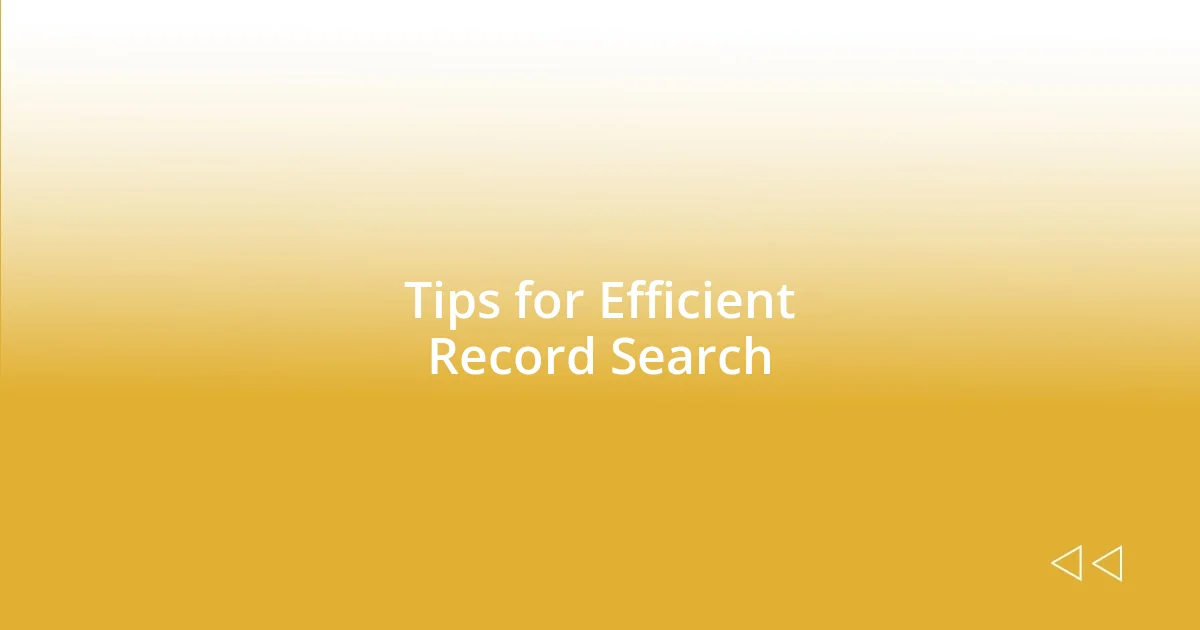
Tips for Efficient Record Search
When searching through parish records, it can be incredibly helpful to have a clear plan. I always make a list of specific details I’m looking for, such as names, dates, and locations. This focus not only saves time but also minimizes the overwhelming feeling that can sometimes come from diving into dense archives. Have you ever walked into a library without a plan and felt lost? Having a roadmap truly makes a difference.
Another tip I find invaluable is to take notes as I go. When I scrutinized a set of burial records, I jotted down every detail that intrigued me, like the age at death and the names of family members listed. Not only did this help me connect the dots between different individuals, but it also sparked new questions I hadn’t considered before. How often do we skip the note-taking process and miss out on golden insights? Trust me, those notes can lead to incredible discoveries later on.
Lastly, I recommend reaching out to local historians or genealogy groups. I once connected with a parish historian who had a wealth of knowledge about a specific family in my tree. The tips she offered not only guided my research but also enriched my understanding of the social dynamics at play during that time. Don’t underestimate the power of a good conversation—have you ever experienced that “aha” moment just by asking the right question? Your queries could unlock personal stories buried deep within those parish records.
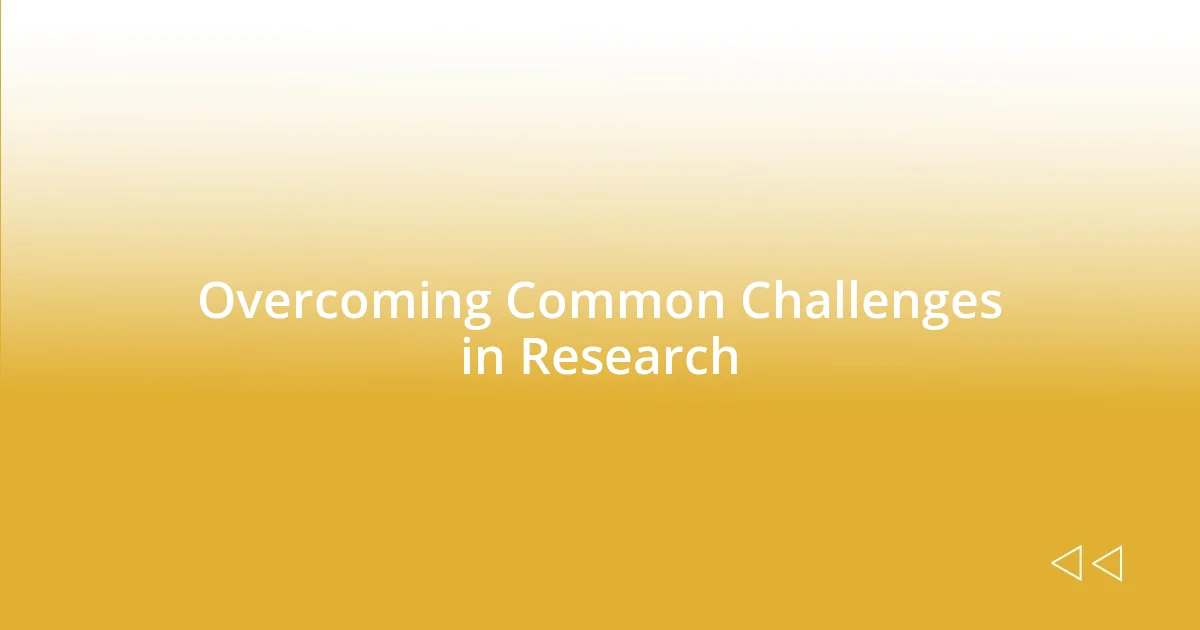
Overcoming Common Challenges in Research
I often encounter a unique challenge with deciphering old handwriting in parish records. I remember a particular moment when I was struggling to read a baptism register filled with fancy script and archaic terms. Instead of getting frustrated, I took a break and returned to it later. Sometimes, stepping back can reveal details that were initially elusive. Have you ever found that a fresh set of eyes—or even some online tutorials on paleography—can turn confusion into understanding?
Another common hurdle is the inconsistency in record-keeping methods across different parishes. I once faced discrepancies in dates when tracing my family through multiple churches, which made me question the accuracy of what I had found. However, I learned to embrace this inconsistency as part of the journey. By cross-referencing records with other historical documents, like local newspapers or census data, I managed to piece together my family’s timeline. Isn’t it fascinating how these intertwining stories create a more comprehensive picture of our ancestry?
Sometimes, a lack of access to physical records can feel daunting, especially when I think of all the incredible information locked away in local archives. One time, I couldn’t travel to a distant village to view its records in person. Rather than letting that discourage me, I reached out via email and was amazed at how responsive the archivists were. They not only provided scanned documents but shared additional resources that propelled my research forward. Have you ever considered how open communication can bridge gaps that seem impossible to cross?

